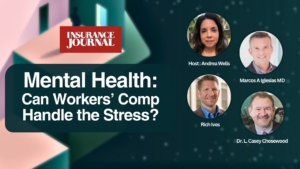American workers are struggling.
Employee stress has reached record highs. Symptoms and formal diagnoses of mental illnesses like anxiety, depression and PTSD are rising. Substance abuse disorders are up, too — as are suicide rates in some demographics.
Understanding how employee well-being impacts workers and employer workers compensation programs has become increasingly important. During a recent Insurance Journal webinar event, three experts discussed the impact of overall worker health and well-being on workplace safety and risk.
Each presented a unique perspective. Throughout the webinar, though, the three panelists seemed to agree: It’s crucial for employers to encourage workplace environments that help employees perform at their very best.
Rising Diagnoses
Dr. L. Casey Chosewood works for the National Institute for Occupational Safety and Health as associate director of strategic initiatives and director of the office of total worker health.
Before the pandemic, he said, about one-in-three or one-in-four workers would report a mental health condition over the course of their careers. During the pandemic, however, that same level of reporting was seen over just a two-year period.
Chosewood emphasized the importance of employers being open to discussing issues of mental health and providing resources to assist workers facing these challenges. He said he has been told that about one-in-three workers report that their mental health has worsened as they transition back to life after the pandemic.
Dr. Marcos Iglesias, chief medical director and vice president at Travelers Insurance, pointed to an increase in employee burnout, which is associated with feelings of exhaustion, disengagement and depleted energy levels. Forty-one percent of U.S. workers report feeling burnout — the highest level since May 2021.
“I think the pandemic accelerated some things,” Iglesias said. “It did make us much more open to talking about some of these things, and that is very good. But that’s only part of where we need to be. We need some solutions, and we need to help people engage back into society and into their lives.”
Rich Ives, vice president of business insurance claims, Travelers Insurance, said that Travelers’ data shows a recent trend of higher proportions of injured employees experiencing mental well-being challenges as well.
Claims Trends
Travelers’ recently released 2023 Injury Impact Report analyzes five years of workers compensation injuries from more than 1.2 million claims. Ives highlighted several important takeaways from the report, the first being that newer employees are at a greater risk of injury.
“First-year employees, regardless of age or industry experience, accounted for 34 percent of all claims — and nearly seven million missed workdays in the sample that we looked at,” Ives said. “Which is a little out of pattern, given that first-year employees make up 20 percent of the American workforce.”
Second: An employee’s age was a driving factor in the cost of claims. In other words, older workers, while lower in frequency, have a higher severity than their younger coworkers for the same or similar injuries, according to Ives.
This is noteworthy, he said, given the aging of the workforce. The U.S. Bureau of Labor Statistics projects the number of people in the workforce who are 65 years old and older will account for more than 60 percent of the growth in the labor force during the current decade.
Lastly, Travelers noted an increase in the number of missed workdays among injured workers overall. The injuries Travelers analyzed accounted for more than 18 million days of missed work due to a workplace injury. That’s up from the previous year’s Injury Impact report, which counted only 17 million missed days. The average duration of a workers comp injury is 71 days.
The newer trend of remote working hasn’t really added to workers comp claims in a big way, he added. According to Ives, less than 1 percent of Travelers’ workers compensation claims come from individuals who work at home.
While mental health claims are not always a compensable workers comp claim, they can be in some cases. When explaining the criteria for compensable mental claims, Ives first highlighted the necessity for the claim to “arise out of course and scope of work.” In the U.S., each state system determines what they deem compensable workers compensation claims. In most states, for example, if a first responder witnesses a traumatic event, psychological issues that arise after that event are often defined as compensable.
Do Employees Value Mental Health Care?
Employers addressing mental health by offering employee benefit options may find that helpful in today’s competitive hiring landscape.
According to Iglesias, a recent survey shows that 41 percent of employees are seeking employers who offer benefits such as mental health care. They’re looking for more than just a paycheck, he said. They’re looking for meaning, purpose, work-life balance and mental health benefits.
“That puts an onus on employers,” Iglesias said. “I think it’s crucial that employers understand that this is something that people are looking for and develop comprehensive programs that are going to address those needs.”
He said that a comprehensive approach that develops a culture of health and well-being is part of the solution. This includes raising mental health awareness, providing workforce education, and addressing prevention and intervention help when needed.
Employers may feel comfortable setting up an office high blood pressure screening. But, he asked, how comfortable would they be setting up screenings for depression or other mental health issues? Forward-thinking companies and employers recognize the value, he said.
Dr. Chosewood said that NIOSH research shows that workplace policies, programs and practices can directly influence the health of Americans in both positive and negative ways. NIOSH’s Total Worker Health program, which is about two decades old, analyzes some of these factors and provides a roadmap to better performance, fewer injuries and lower spending for workers compensation and health care, among others benefits.
“We’ve analyzed those companies that have this comprehensive approach, and they succeed,” Chosewood said.
One way to help the well-being of workers today is to offer flexible options, Chosewood added. The full story has yet to be written on how the increase in remote work has changed relationships with coworkers — and employee lives, he said. Early research findings show those who do well from a mental health standpoint have the option to work from home and the office, he added.
“They have the highest level of reported positive mental health,” Chosewood explained, followed by those who work in person full time. Those reporting the highest levels of mental distress and mental health symptoms are full-time remote workers, he added.
It is early in data tracking for remote work and worker well-being. He stressed these findings come from one study with early data — but added it’s clear that benefits like flexibility and decreasing commutes are weighed against feelings of loneliness and disconnection from coworkers. Finding a mix and offering flexibility is “probably the sweet spot for most workers,” he said.
To watch the full webinar, “Mental Health: Can Workers’ Comp Handle the Stress?” — which includes conversations regarding small businesses, the intersection of mental health and delayed recovery, as well as other connections between the industry, employers and workers today — visit: https://www.insurancejournal.com/research/research/mental-health-can-workers-comp-handle-the-stress.





















 Underwriter, Actuary Fears of AI Drop; Work Needed on Collaboration
Underwriter, Actuary Fears of AI Drop; Work Needed on Collaboration  Slideshow: Carrier Management’s 2025 Top Editor’s Picks (Unlocked)
Slideshow: Carrier Management’s 2025 Top Editor’s Picks (Unlocked)  Artificial Intelligence Is Rewriting the Rules for Commercial Lines
Artificial Intelligence Is Rewriting the Rules for Commercial Lines  Why the Middle Market Matters and How Insurers Can Capture It
Why the Middle Market Matters and How Insurers Can Capture It 
